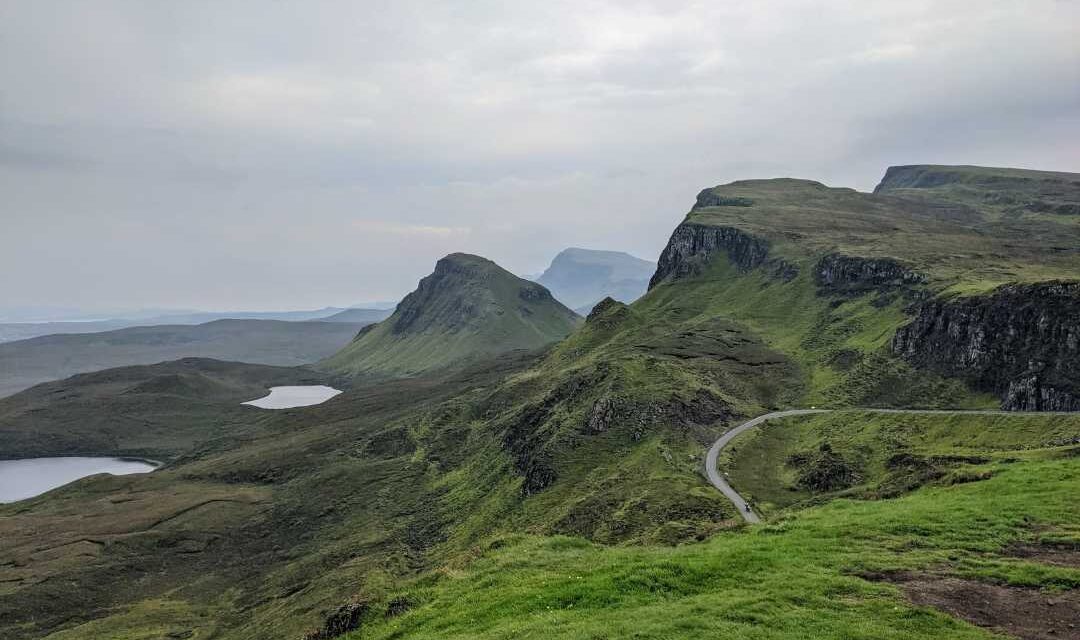Scotland’s Trotternish Peninsula on the Isle of Skye is a geological masterpiece.
Here, ancient landslides have formed a landscape that appears otherworldly. Jagged pinnacles balance atop hills that roll down into glimmering lochs, waterfalls tumble over cliffs and fossilised dinosaur footprints pepper the shore.
Trotternish holds jaw-dropping wonders and all of them can be seen on a mini road trip known as the Trotternish Loop.
In this article, I’ll share the top attractions on this scenic drive on the Isle of Skye, how to do it and top tips to know before you go.
What is the Isle of Skye’s Trotternish Loop?
The Trotternish Loop is a circuit (or mini road trip) around Skye’s Trotternish Peninsula in the northeast of the island.
The circuit offers some of the most dramatic scenery on the island – and even Scotland! Famous landmarks on this epic route include the Old Man of Storr, Quiraing, Fairy Glen and Flora McDonald’s grave.
It covers 50 miles and takes at least about 2-2.5 hours to complete if you’re driving. That’s without any stops though so really, I recommend a whole day – maybe longer if you want to do the hikes!
The loop is popular so I would avoid peak season if you can help it. Read my Isle of Skye itinerary to plan your trip.
Trotternish Loop map
How do you do the Trotternish Loop?
It’s technically a road trip, so the easiest way to do it is to drive it. If you don’t drive fear not, there are ways around but it will take longer.
Transport options include buses, tours and e-bikes.
Here are the easiest ways to do the Trotternish Loop:
By car
By car is the easiest and most flexible way. Driving the Trotternish Loop allows you to stop when you fancy and take as long as you want to complete the circuit. The main roads are well-kept too.
The one small factor to be aware of is that parking is limited. Most of the car parks at the stops are either lay-bys or unmarked. Established car parks like the one at Fairy Glen require you to pay.
Need to hire a car? Compare the best prices on RentalCars.com.
Public transport
There’s a bus route that goes around the main circuit. The number 57 bus links all the main villages and settlements across the peninsula.
You’ll need to get off to fully enjoy the stops you want so make sure you take an up-to-date timetable and note down the first and last buses. Stagecoach also has an app with live bus times.
Some stops might require you to walk a bit to reach the landmarks you’re hoping to see.
It might not be practical to attempt the entire Trotternish Loop by bus – at least in one day. I recommend prioritising a few stops instead.
E-bike

Doing the loop with an e-bike is the next best option if you’re not driving. Again, it’s unlikely you’ll manage the entire loop but you have a lot more freedom to stop as and when.
Skye Ebikes allows you to hire e-bikes for the day at a reasonable price.
You can then do one of two recommended routes – Trotternish Explorer Route which takes you around the northern tip. Or, the North Coast Storr Route which leads you right down the east coast to the Old Man of Storr.
There are pros and cons to each route. The Trotternish Explorer misses out on the Old Man of Storr whereas the North Coast Storr misses out on the Quiraing.
One way to get around it would be to do the Trotternish Explorer one day and take a bus to the Storr the next.
Tours
So, what about tours? If you’re short on time and want to see as much of Skye as possible, I recommend doing a best of the Isle of Skye full day tour.
The small group trip takes you to all the main attractions on the island including the highlights of the Trotternish Peninsula like the Storr and Quiraing.
You’ll also get to see other Isle of Skye attractions such as Dunvegan Castle and the Fairy Pools.
The main drawback of doing a tour is that you don’t have the freedom and flexibility to see the whole of the Trotternish Loop, but you get a snapshot at least.
Editor’s tip: Wondering whether to do the Trotternish Loop clockwise or anti-clockwise? I recommend doing it anti-clockwise if it’s a self-guided road trip. The Quiraing has some steep hills which are better to go down rather than up! Anti-clockwise is also the direction that most of the traffic goes.
The best things to see on the Trotternish Loop
From ancient landslides to dinosaur footprints and needle-sharp boulders, here are the best landmarks and attractions to see on this Isle of Skye road trip:
Portree
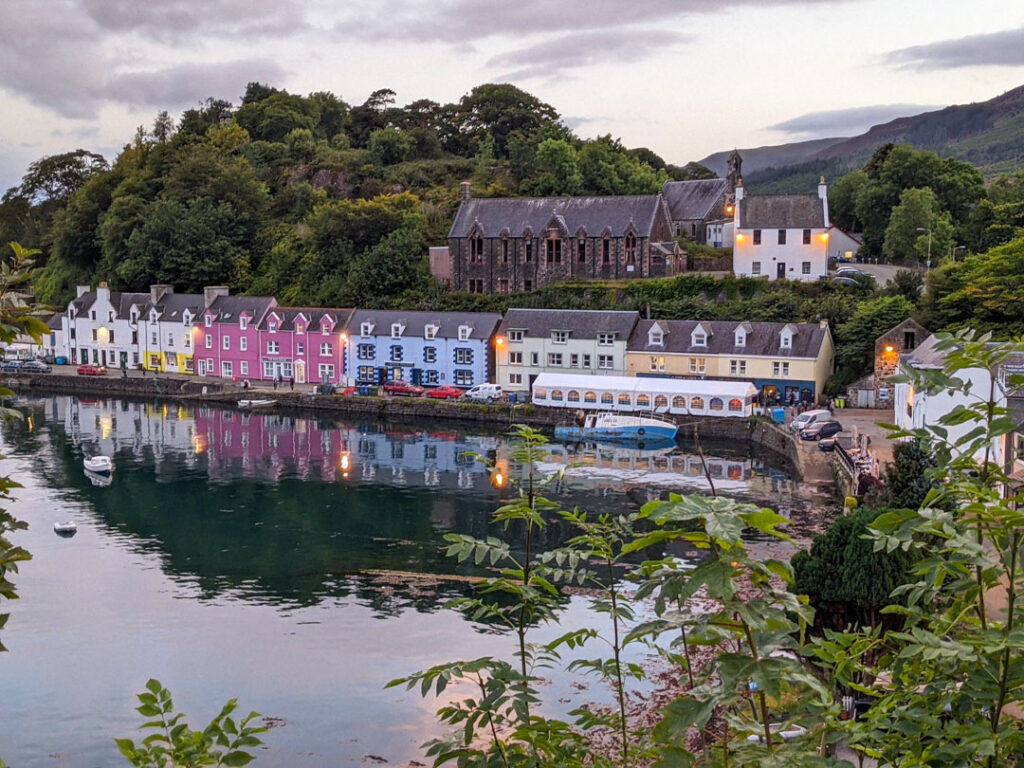
The capital settlement on the Isle of Skye, Portree is a harbour town with a few shops, restaurants, pubs and colourful houses.
It sits on the coast at the base of the peninsula so it’s a good start and end point. It’s also well connected by buses.
Popular places to eat include Sea Breezes and Cafe Arriba. Although, if you’re keen to keep costs down, Pizzaway does reasonably priced wood-fired pizza with vegetarian and vegan options. It’s only open seasonally though.
There’s also a small Co-Op so you can stock up on food and snacks before you do the loop!
Bride’s Veil Falls
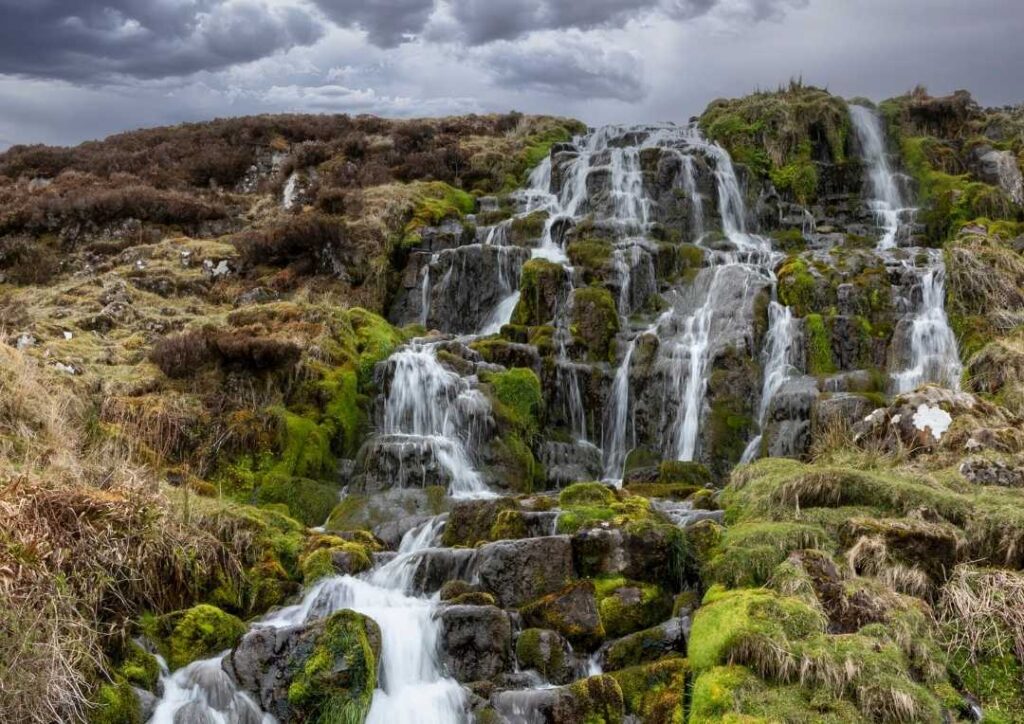
The first stop on the circuit is Bride’s Veil Falls. The waterfall tumbles down the hillside almost like, well, a bride’s veil!
You can see it clearly from the roadside but it’s worth doing the short scrambly walk to the top of the falls for surrounding mountain views and a glimpse of the Old Man of Storr.
The walk is about 0.25km and has a moderately easy difficulty level. It does get quite boggy so wear walking boots and insect repellent – for the midges!
Where to park: There isn’t an official car park so you’ll need to pull to the lefthand side of the road on the A855 as you drive to the Old Man of Storr.
Editor’s tip: Watch out for midges on Skye. Although these small flies are harmless, their bites can be irritating. Midges love boggy areas and they’re most active around dawn and dusk. Wear midge repellent and cover up as much as possible.
Old Man of Storr

Probably THE most famous landmark on Skye, the Old Man of Storr – or, the Storr – is a rocky pinnacle that stands needle-sharp on top of a hill. It can be seen for miles around.
The landmark was created by an ancient landslide, leaving behind a captivating view. To top it off, the dramatic hilly landscape gives way to views across the Sound of Raasay as a backdrop.
The Storr has the most popular walk on Skye and it’s well worth doing it if you have time.
It’s an out-and-back trail and takes about one hour and 15 minutes to complete (without stops). It’s a medium difficulty level.
The hiking trail:
- Follow the gravel path through the wooden gate at the end of the car park
- When the path splits take the righthand one (they both re-join later)
- Walk through a commercial forest area until the gravel path runs out
- The next section of the path is muddy and a little steep but well-worn
- Follow the left-hand split with uneven steps guiding you uphill
- The path turns right to face the Storr. It’s steep and scrambly so proceed with care
- If you continue, you’ll reach the foot of the Storr and be greeted by panoramic views
- To head back, follow the path back the way you came
Where to park: Off the main road 6.8 miles from Portree you’ll find the Old Man of Storr car park. The postcode is IV51 9HX.
Lealt Falls Viewpoint
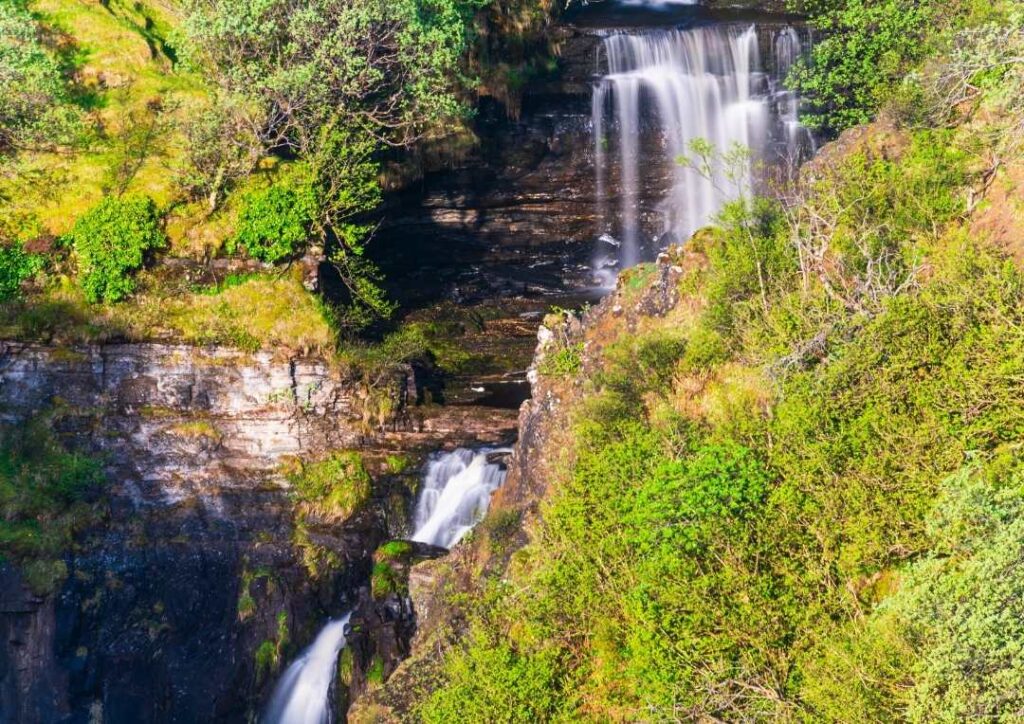
Back on the road, the next stop is yep, another waterfall! Lealt Falls is a beautiful cascade that thunders through a gorge close to the A855 road.
A relatively new viewing platform makes it easy to see the upper falls but the lower falls are much more dramatic.
The upper falls viewpoint is right next to the car park. The lower viewpoint is a 30-minute moderate walk out and back. It’s well-marked but a little steep and zigzags downhill.
You’ll catch a glimpse of Inver Tote Bay before arriving at the base of Lealt Falls.
Where to park: There’s a sizable car park here with beautiful short walks surrounding it. The address is Lealt, Portree IV51 9JW.
Rubha nam Brathairean
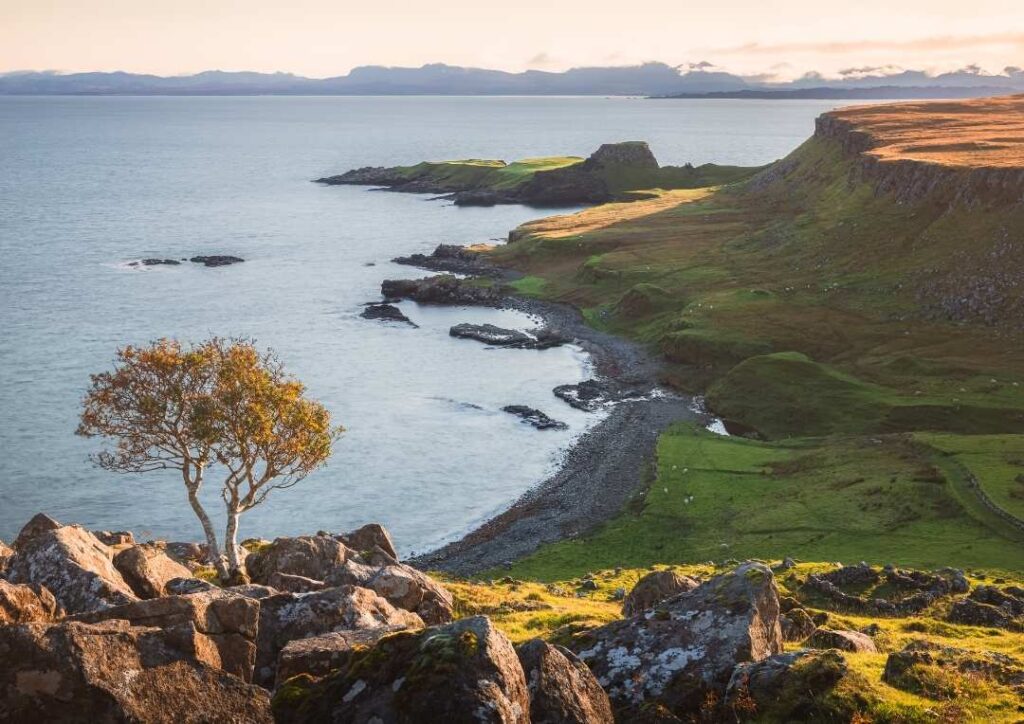
Rubha nam Brathairean or Brother’s Point is a dramatic headland that juts out into the North Atlantic Ocean. It marks the easternmost point of the Isle of Skye and offers panoramic ocean views at the end of a walk.
It’s an easy out-and-back route and takes around an hour to complete. Most of the trail leads you through sheep farms and you’ll pass by ruins of an old salmon netting station. There are some sharp cliffs to watch out for.
Brother’s Point is a lovely trail to do if you have time but you don’t have to get to the end to enjoy the coastal scenery.
Where to park: park in the lay-by on the left at Culnacnoc as you drive up the A855 from Portree. It’s just before the Skye Pie cafe.
Kilt Rock & Mealt Falls

Two attractions in one! Just off the main road lies a cliff where a waterfall tumbles off the side and 55m down to the sea below. It’s not a huge waterfall so I recommend managing your expectations a little.
In the distance, you can see another cliff face jutting out. Made of basalt stone, the 90m cliff looks like the pleats of a tartan kilt – hence its name!
On a clear day, you can catch a glimpse of the Isle of Lewis across the water.
Where to park: The car park can be found off the A855 at Ellishadder. It’s not marked and it can get busy – particularly during the summer.
An Corran Beach & Dinosaur Footprints

An Corran Beach lets you travel back 170 million years ago to a time when dinosaurs walked the earth – Megalosaurus dinosaurs no less!
Here you can find nearly 20 fossilised dinosaur footprints scattered across the rocks. To the untrained eye, they’re pretty hard to find.
Your best chance of seeing them is at mid-tide as they’re often covered by sand and seaweed. It can get slippery so be careful!
An Corran is also the only sandy beach on the island so it’s a good place to stop for a rest and a picnic on a sunny day.
Where to park: You can either park at Staffin Harbour car park or along the side of the road that runs to the beach.
Quiraing

The Quiraing is the second most popular natural attraction on Skye after the Storr. Also caused by a landslide, the undulating landscape forms dramatic slopes, hills and plateaus pockmarked with glimmering lochs.
There’s a viewpoint a short walk from the car park and a slightly longer walking trail that takes you through the heart of the Quiraing. You certainly won’t be disappointed by the viewpoint but the hike is worth doing if you have time.
The hike is a loop which takes about two hours to complete and is labelled as a moderate level of difficulty.
The hiking trail:
- Follow the path north of the car park which leads you to the plateau viewpoint too
- The path is clear but it can get rocky and steep in places with a scramble over a gully
- Soon you’ll find yourself between the Quiraing cliffs and a rock formation known as the Prison
- Take the path across the slope and around a dramatic overhang until you reach a fork
- Take the left fork to find a glen marked with rocks – be careful of the eroded track
- You’ll soon reach a ridge which has epic views. Turn left and ascend for even better views
- Finally, you’ll reach the highest part of the cliff edge with dramatic landslip views surrounding you
- Follow the path as it begins to descend and keep going until you reach the car park
Where to park: Unnamed Road, Portree, Sartle, Staffin, IV51 9LB
Editor’s tip: Both the Quiraing and the Old Man of Storr are in a landscape area known as the Trotternish Ridge which was formed as a result of the landslide.
Duntulm Castle

Not a whole lot remains of this fifteenth-century castle but since it’s just off the main road, it’s worth a quick look.
Its strong position on the coast has suggested that a fortress of some kind has been there since the Iron Age – although no archaeological evidence has been found.
What remains there now is a crumbling ruin of Duntulm Castle, the once ancestral seat of Clan MacDonald of Sleat. It’s been abandoned since the 1730s.
You can’t go into the castle ruins as it’s far too dangerous. Instead, you can take a short walk across the headland and see what’s left of it.
Where to park: There’s a lay-by just off the A855 where you can park. It’s unmarked and gets very busy!
Flora McDonald’s Grave
If you’re into your Scottish history, Kilmuir Cemetery is an unmissable stop. Within it lies the grave of Flora MacDonald, a Jacobite heroine.
In 1746, she helped Bonnie Prince Charlie escape to Skye after the Jacobites lost the Battle of Culloden. Disguised as an Irish spinning maid, the Bonnie Prince travelled to Moidart where he was rescued by a French ship and taken to Europe.
Flora herself admitted that it wasn’t the Jacobite cause that led her to do it, but rather she pitied the prince.
She was imprisoned in the Tower of London but was later released and emigrated to North Carolina. She returned to Skye and died in 1790. A large memorial stands by her grave.
Where to park: You can park outside the cemetery
Editor’s tip: Outlander fans! Outlander’s Skye Boat Song for the opening credits was adapted from the original which tells the story of Flora and the prince’s crossing.
Skye Museum of Island Life

A short walk from the cemetery is the Museum of Island Life which showcases what Highland life was like hundreds of years ago.
The museum of a collection of historic thatched roof cottages. It’s open Monday to Saturday from 10am-5pm and costs £6 to enter.
If it’s closed when you turn up (it was for me) you can still get a feel of the history and lifestyle by looking around the outside of the squat cottages.
Where to park: Same as Kilmuir Cemetery or park at the museum.
Iron Age Souterrain
A nice little stop that doesn’t get many visitors is the Iron Age Souterrain in a field in Kilvaxter. It’s essentially a small underground passage but it’s unclear what it was used for. Most likely, food storage.
The souterrain is 20m in length and built from stone. There’s a ventilation shaft and an entrance. Inside, the passage is narrow and low so you’ll need to watch your head if you enter. It’s pitch black too so bring a torch or use your phone.
Where to park: There’s a small car park on the east side of the road.
Fairy Glen
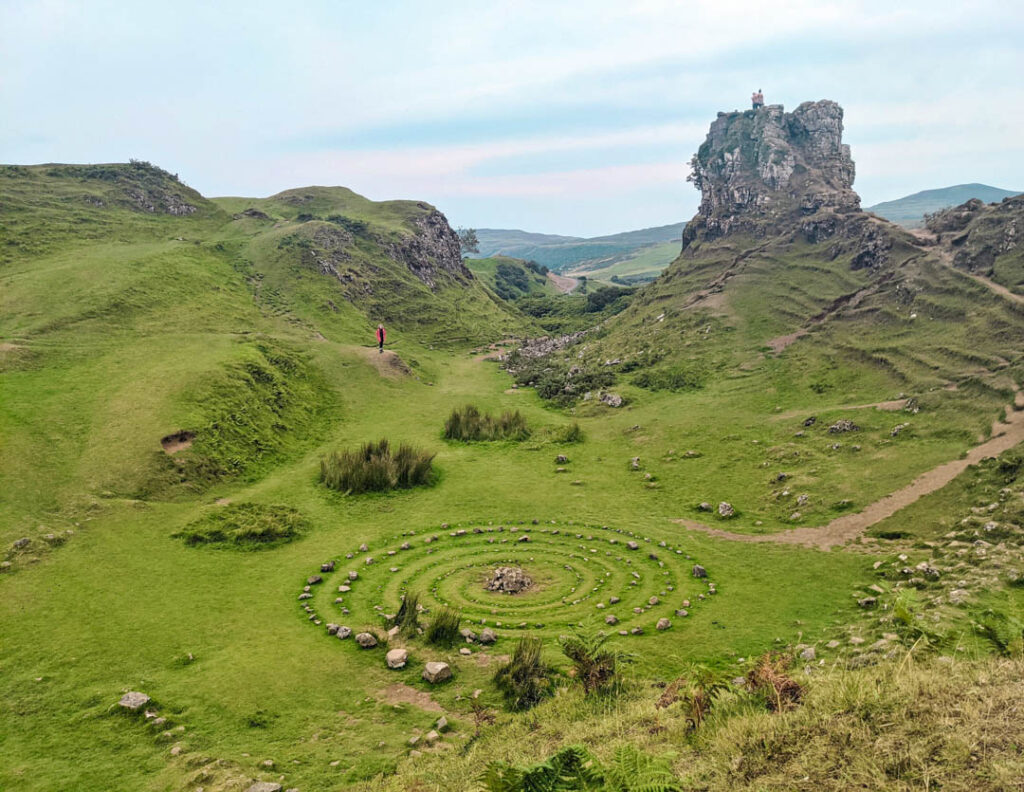
The final stop on this Trotternish Peninsula road trip is Fairy Glen and it’s absolutely worth the wait.
Just above Uig on the west side of the peninsula, the Fairy Glen is like a miniature version of the Quiraing.
Formed by an ancient landslip (you can see a pattern here…), the glen is made up of small round hillocks and ponds which make you think you’ve stumbled into fairyland.
In the centre, a tall basalt rock stands on a hill giving it the illusion of a castle – in fact, it’s called Castle Ewen. It’s possible to climb to the top for some stunning views.
Directly below is a flat area of grass with a stone spiral at the far end.
Visitors rather than fairies have made the stone spiral but I don’t recommend taking part. The local community frequently remove stones and other trinkets to keep the site in its most natural state possible.
Where to park: Fairy Glen Parking is a well-sized car park with extra spaces on the side of the road. It’s right by the entrance to the Fairy Glen.
Trotternish Loop Skye frequently asked questions
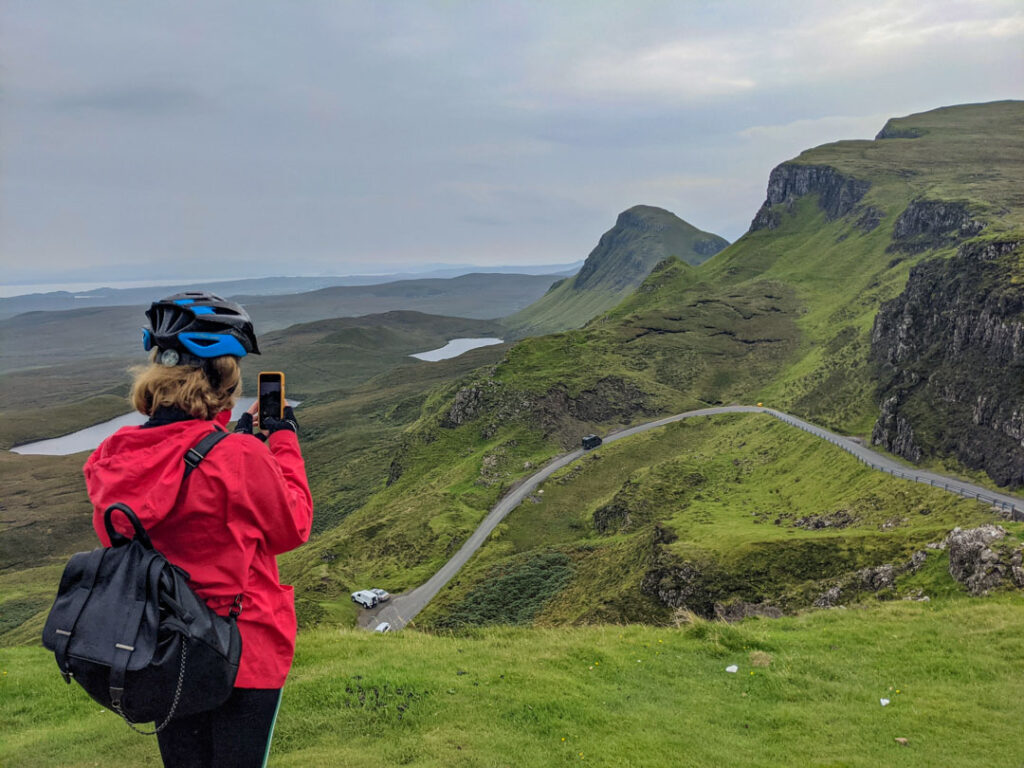
Here’s what you need to know to plan your trip, including Trotternish weather and more:
How do you get to the Trotternish Peninsula?
The Trottenish Peninsula is the northernmost peninsula on the Isle of Skye which is just off the west coast of Scotland. Its most northern tip, Rubha Huish is also the most northern part of the whole island.
To reach the Trotternish Peninsula, you first need to get to Skye from the mainland. There are two ways to get to Skye:
- The ferry from Mallaig to Armadale
- The Skye Bridge at Kyle of Lochalsh
You’ll then need to make your way to Portree, Skye’s capital settlement and first stop at the base of the peninsula. It’s located on the A87 road.
It’s possible to both drive or take the bus from the mainland to Portree. If you’re travelling by bus, you’ll need the 917 from Fort William which will take you over the Skye Bridge.
If you’re travelling via Armadale, get the 52 to Broadford and then either the 915, 916 or 917 to Portree.
From Portree, drive northeast on the A855 to reach Bride’s Veil Falls, the next stop on the loop (if you choose to go anti-clockwise which I recommend!).
If you’re not driving, you’ll either need to get a bus or taxi to Kilmuir to pick up your e-bike or catch the 57 bus from Portree.
Note, the bus goes both clockwise and anti-clockwise around the peninsula and you’ll need to get off to enjoy the stops!
When is the best time to visit the Isle of Skye?
April and May get the least amount of rain so they’re good months to visit Skye. September and October are less busy with tourists than the summer but they get a lot more rainfall.
Read my guide to the best time to visit Skye to beat the crowds and the rain. Discover what wildlife to see plus when and where to see the northern lights!
How can you avoid crowds on the Trotternish Loop?
The Isle of Skye is one of the most popular destinations in Scotland so the loop gets very busy.
If you want a quieter experience, avoid July and August (peak season) and opt for shoulder seasons such as May or October instead.
If summer is the only time you can visit, try to do the Trotternish Loop early in the morning as there won’t be such a huge demand for parking spaces.
I did it in September and it was still pretty busy!
What are the roads like on the Trotternish Peninsula?
The peninsula’s main roads, A855 and A87 are very well maintained Off the main roads, many of them are single track with passing places throughout.
Roads are bendy and a few junctions or turnings are partially hidden so some care is needed.
Watch out for roaming sheep wandering onto the road too!
A note on parking
Most of the unmarked car parks and lay-bys (like the one at the Quiraing) are free but they get filled up fast. More well-established car parks such as Fairy Glen require you to pay and you will need some change.
If you want an easier time parking then I recommend doing the loop early or outside peak season.
For cyclists, there’s virtually nowhere decent to store your bike. You’ll either have to look for a pole or take turns watching them if there’s more than one of you.
I honestly think Skye is missing a trick by not accommodating cyclists as well. Better facilities will only lead to fewer cars on the road!
Where should you stay on Skye for the Trotternish Loop?
The most accessible (and convenient) area to stay on the Trotternish Loop is Portree as you can begin and end your road trip there.
Another popular but slightly more remote area is Uig, a village on the west coast of the peninsula.
If you need help deciding your accommodation, I’ve put together a guide to the best places to stay on Skye for every type of budget.
Final thoughts on the Trotternish Loop
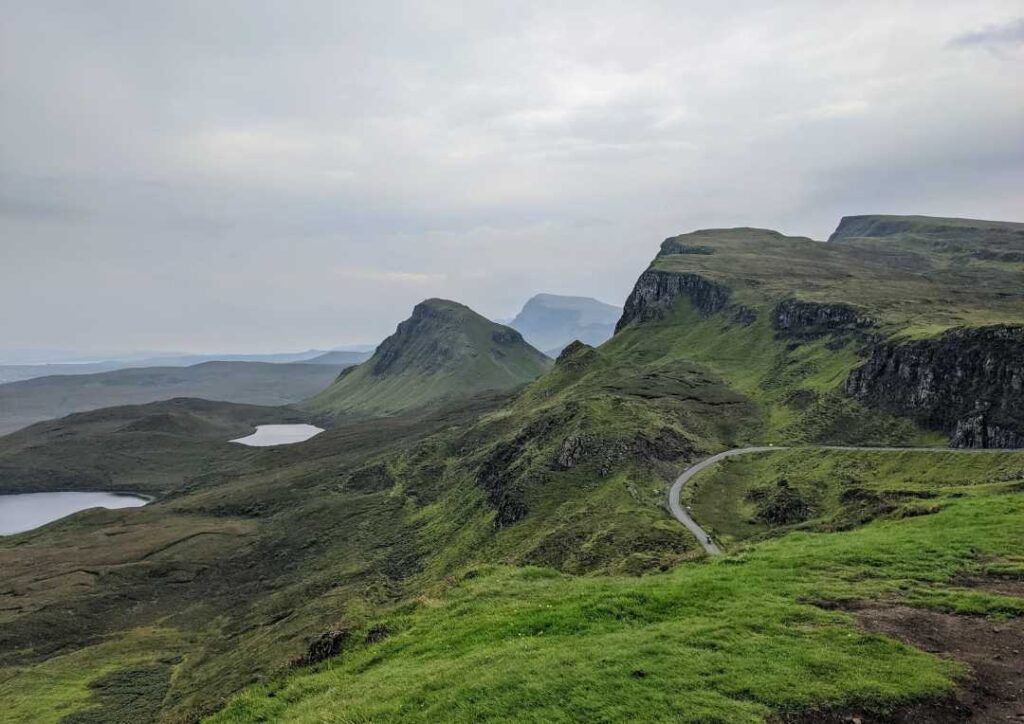
The Trotternish Loop connects some of the most famous landmarks on Skye – and even Scotland. It’s no wonder it’s so popular!
This mini Scottish road trip offers some of the most beautiful landscapes and natural sights so it’s 100% not to be missed when visiting Skye on your Scotland West Coast itinerary.
I recommend spending a whole day at least to see it all without rushing. Although, if you’re short on time, I’d prioritise Fairy Glen, Quiraing and the Old Man of Storr.
While taking a car or campervan is the easiest option, there are other ways to quite literally get around it so don’t feel discouraged if you don’t drive.
Want more Scotland travel tips? Check out these articles!
- Ultimate Scotland Travel Guide: What To Known Before You Go
- 12 BEST Day Hikes In Scotland You Need To Experience
- 10 Days in the Scottish Highlands: The Ultimate Itinerary
- 20 Best Things To Do On The Isle Of Mull
- 13 Awesome Day Trips From Edinburgh By Train Or Bus
This post may contain affiliate / compensated links. As an Amazon Associate, I also earn from qualifying purchases. For full information, please see my disclaimer here.

